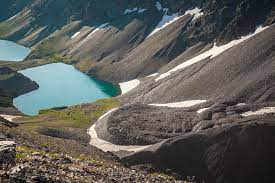Rock Glaciers : Study

A new study revealed that over 100 active permafrost structures identified in the Jhelum basin, can cause catastrophic disasters in future.
- A rock glacier is a mass of rock, ice, snow, mud, and water that moves slowly down a mountain under the influence of gravity.
- Unlike an ice glacier, rock glaciers usually have very little ice visible at the surface.
- The rock glacier might consist of a mass of ice covered by rock debris, or it might consist of a mass of rock with interstitial ice.
- Rock glaciers typically form in mountainous regions where there is a combination of permafrost, rock debris, and ice.
- One common scenario involves a pre-existing glacier that accumulates debris and rocks as it moves.
- Over time, if the glacier recedes or thaws, the debris-covered ice can transform into a rock glacier.
- These are classified as ‘active’ or ‘relict’ to indicate the status of permafrost within them, identified by the appearance of the rock surfaces.
- It increases the risk of glacial lake outburst floods (GLOFs).
- It may also make landslides more frequent with the land on the melting ice becoming loose.




